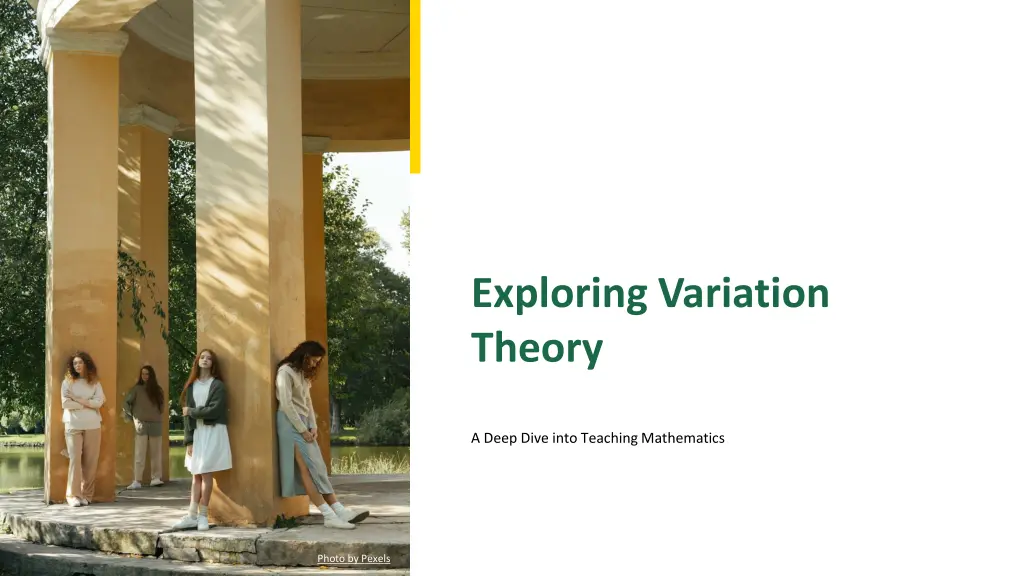
Deep Dive into Exploring Variation Theory in Mathematics Teaching
Explore the essence of Variation Theory in teaching mathematics, emphasizing how differences and similarities enhance comprehension. Discover key components, practical applications, learning outcomes, and challenges in implementing this approach to inspire change in education.
Download Presentation

Please find below an Image/Link to download the presentation.
The content on the website is provided AS IS for your information and personal use only. It may not be sold, licensed, or shared on other websites without obtaining consent from the author. If you encounter any issues during the download, it is possible that the publisher has removed the file from their server.
You are allowed to download the files provided on this website for personal or commercial use, subject to the condition that they are used lawfully. All files are the property of their respective owners.
The content on the website is provided AS IS for your information and personal use only. It may not be sold, licensed, or shared on other websites without obtaining consent from the author.
E N D
Presentation Transcript
Exploring Variation Theory A Deep Dive into Teaching Mathematics Photo by Pexels
01 Understanding Variation Theory Table of Contents 02 Key Components of Variation Theory 03 Practical Applications in Teaching 04 Learning Outcomes Through Variation 05 Challenges in Implementing Variation Theory 06 Inspiring Change in Education 07 Conclusion: Embracing Variation
1 Understanding Variation Theory The Essence of Variation Variation theory emphasizes how different aspects of content are highlighted in teaching to foster deep understanding in learners. It shows that learning occurs when students can discern differences and similarities in mathematical concepts, enhancing their comprehension. By focusing on variation, teachers can design their instruction to help students grasp essential features of mathematical ideas more effectively. This approach caters to diverse learning needs, enabling every studentto engage with mathematics meaningfully. Photo by Pexels
2 Key Components of Variation Theory The Core Ideas At its heart, variation theory identifies critical features of a concept, allowing students to focus on what truly matters in learning. It includes the principles of discernment, where students learn to see the relationships between different mathematical ideas. By exposing learners to varied representations, they can better understand underlying principles and applications of mathematical concepts. This creates a pathway for deeper engagement and mastery of the subject. Photo by Pexels
3 Practical Applications in Teaching Implementing Variation Theory Teachers can apply variation theory by structuring lessons that spotlight the essential features of mathematical concepts. Using varied examples and contexts helps students recognize patterns and build connections among different mathematical ideas. Interactive activities, such as group discussions, allow learners to share their perceptions, enriching their understanding of mathematics. Thus, variation is not just a theory but a practical tool for effective teaching and learning in mathematics. Photo by Pexels
4 Learning Outcomes Through Variation What Students Gain Students exposed to variation theory develop a robust understanding of mathematical concepts, as they learn to differentiate and relate ideas. This enhances their problem-solving skills, enabling them to tackle complex mathematical tasks confidently. Moreover, learners become more adaptable, as they can apply their knowledge in various contexts beyond the classroom. Ultimately, variation theory fosters a love for learning and an appreciation for the beauty of mathematics. Photo by Pexels
5 Challenges in Implementing Variation Theory Overcoming Obstacles While variation theory offers valuable insights, teachers may face challenges in recognizing and emphasizing critical features effectively. Additionally, not all students may grasp the nuances of variation immediately, requiring patience and tailored support from educators. It's crucial for instructors to reflect on their practices and continuously adapt their strategies to meet diverse needs. By embracing these challenges, educators can become champions of variation theory and its benefits in mathematics education. Photo by Pexels
6 Inspiring Change in Education The Call to Action Variation theory challenges traditional methods of teaching mathematics, urging educators to innovate and rethink their approaches. The future of mathematics education depends on our ability to engage students through diverse perspectives and experiences. By fostering an environment where variation is celebrated, we can inspire a new generation of math thinkers and problem solvers. Let us embrace variation theory to transform learning experiences in mathematics for all students. Photo by Pexels
7 Conclusion: Embracing Variation End of the Journey In conclusion, variation theory offers a transformative framework for teaching and learning mathematics effectively. By focusing on the essential features of mathematical concepts, we can nurture students understanding and love for the subject. Let s commit to integrating variation in our teaching practices and inspire every student to reach their full potential in mathematics. Thank you for embarking on this journey through variation theory let's keep learning together! Photo by Pexels
